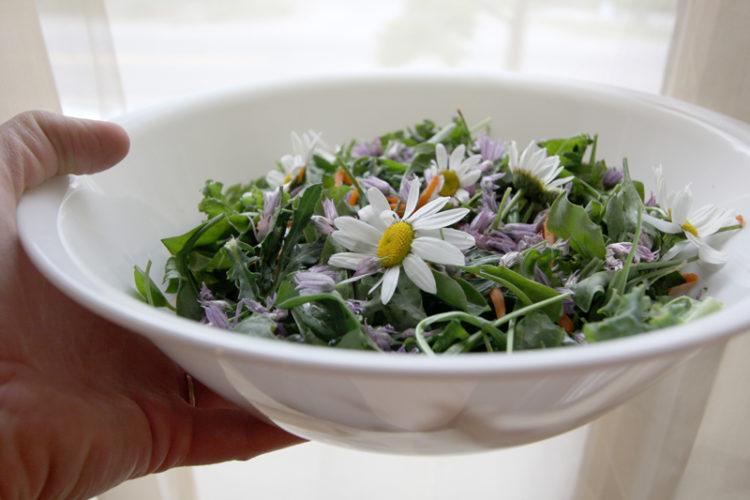
My class and I were invited to forage some edible noxious weeds on a public trail in Breckenridge, Colorado a couple years ago. We saw no signs of herbicide spray there, and I had seen none in past years at that spot, so a couple of us took home nice bags of budding ox-eye daisies (Leucanthemum vulgare), each with a still-thick mass of greens.
In this part of the Colorado high country where I live we have two daisies that are considered to be noxious or harmful weeds. Both the ox-eye daisy and the chamomile daisy are on List B of Colorado’s noxious weed list.
Crazy Daisies are Gross
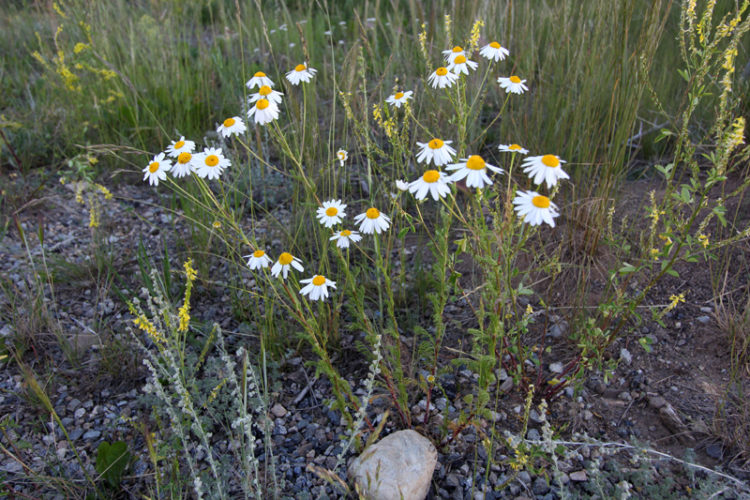
The more widespread of the two noxious daisies in Summit and Park counties is the chamomile daisy, also known as mayweed or scentless daisy (Tripleurospermum perforatum). My friend Nick, who is a landscaper, calls it “crazy daisy.” The crazy daisy has classic daisy flowers with a yellow center and white petals (ray florets). The leaves are frilly or finely divided and quite emerald green when young. After the rosette stage, they bolt tall and proud on sturdy stems, attended by fuzzy leaves.
“All parts are edible except mature roots,” Cattail Bob Seebeck writes of the crazy daisy in his Survival Plants textbook (2012), though he recommends against the roots due to toughness. I have nibbled the greens many times in the hopes of finding some superb use for this invasive species. To this day, however, I find them impossibly bitter at all stages of development, even pickled. The flowers are okay, however.
If you are hoping to try this at home nonetheless, note that folks who have sensitive skin sometimes get a reaction when weeding chamomile daisies without gloves. Such individuals should of course proceed with care in touching them, let alone eating them. The chamomile daisy, along with its similar, scented relative Anthemis cotula—which is listed as edible but earns a low edibility rating of “1” from Plants for a Future (pfaf.org)—may cause reactions similar to hay fever in sensitive people.
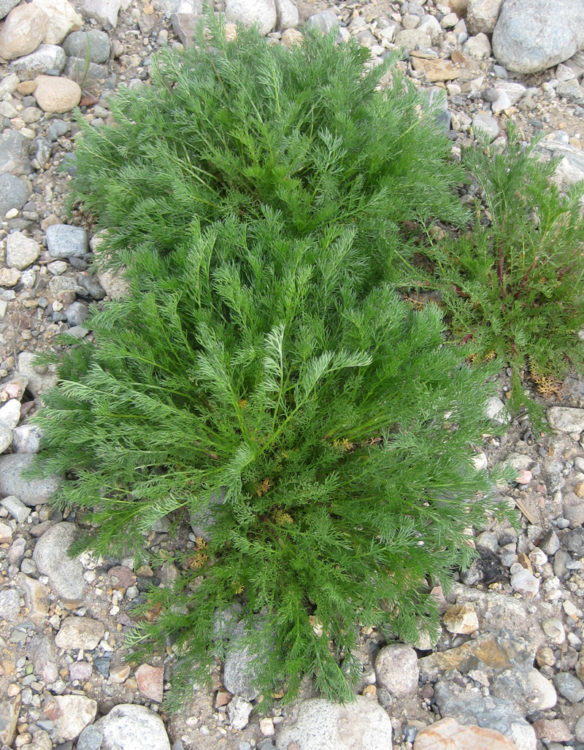
Chamomile daisies are found in pretty much any and all disturbed locations up here, particularly roadsides and recent construction projects. They are quite pernicious and pushy, navigating their way into many landscapes, though they do serve roles in adding biomass to lands laid bare by human hand, and providing for pollinators.
You might notice chamomile daisies that have been sprayed with herbicides. This year for the first time we had some in front of the college where I teach. The sprayed daisies are unmistakable in their various stages of torture and death, hues ranging from green to brown and white as their stems curl grotesquely inward upon themselves. These should not be eaten for obvious reasons. The State of Colorado mandates control of chamomile daisy and other “noxious weeds” deemed harmful to agriculture, ranchland, or native ecosytems. There is a three-tiered list from the worst offenders (List A) to lesser offenders (List C). Local counties and towns implement the law in accordance to their own management plans, which generally involve herbicide applications.
Mechanical removal is another option, provided you pull them before they go to flower or seed so they can’t reproduce. This point is a reminder to brush off our pants and shoes if we walk through a field of noxious daisy flowers, before treading onward to native landscapes.
Ox-eye Daisies are Good Eatin’
Ox-eye daises (Leucanthemum vulgare) are also on the noxious weed list in Colorado. Unlike the frilly leaves of chamomile daisies, ox-eye daisies have thicker, dark green, lobed leaves. Those on the basal rosette are spoon-shaped—narrow and elongated down low, then widening toward the tip, with scalloped or shallowly lobed margins. The stem leaves that develop later tend to be smaller, with lobes or teeth that can be thin, short, and widely spaced into funny little nubbins. The leaves are borne alternately along the stalk.
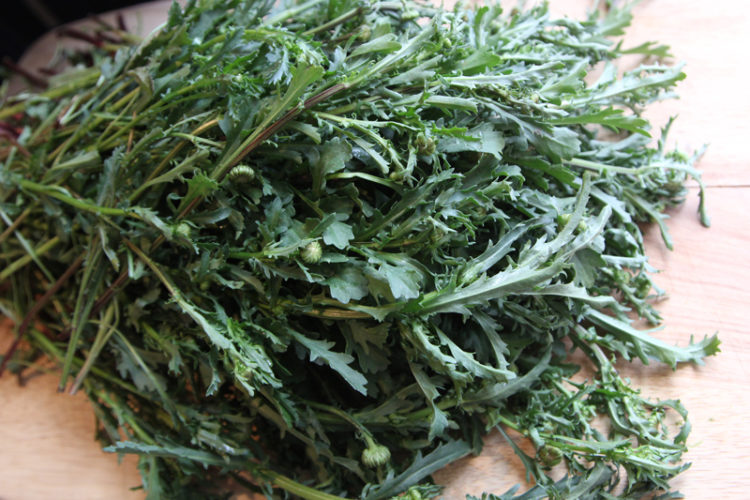
Many people like ox-eye daises—after all, they do make pretty flowers. So they plant or encourage them in their landscapes, and the daisies spread. High country folks looking to brighten their yards with daisies’ cheer should look instead to native daisies (Erigeron spp.), black-eyed susan (Rudbeckia hirta), and blanket flower (Gaillardia aristata), Summit County’s Weed Guide recommends.
I subjected the ox-eye daisies we got from the weed pull—which had already bolted but still sported leafy foliage, not to mention soft stems and flower buds—to many kitchen experiments, as I rarely get such a large bunch of them. I stripped the leaves and buds into salads, served them atop tacos, and added them to stir fries. I chopped them fine into a potato salad, and sautéed them in bacon fat to have first on an egg sandwich and later a tortilla pizza constructed with piles of yummy browned sausage. Oxeye daisies have a strong and unique, somewhat sweet flavor that I like—sparingly in mild dishes, or en masse balanced by other strong-flavored ingredients.
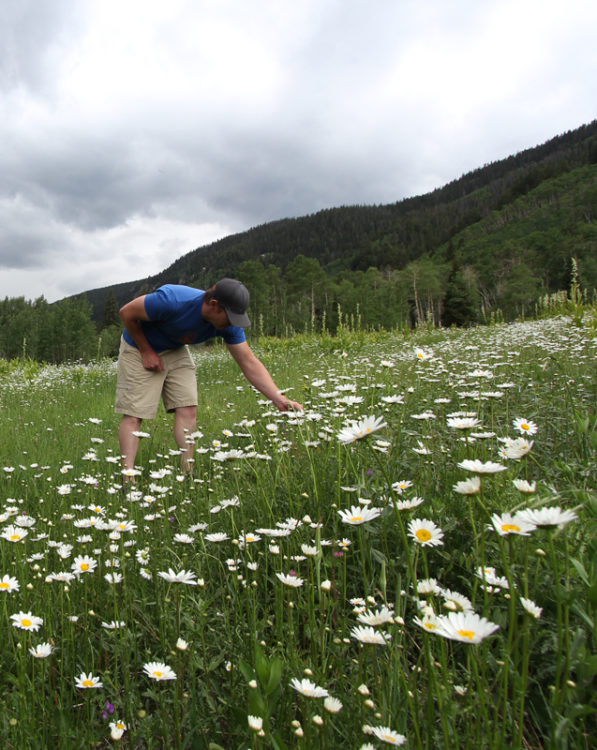
The field behind Beano’s Cabin in Beaver Creek where our friend Bill Greenwood is chef is covered in ox-eye daisies. It makes for a pretty sight when they’re in bloom, but the best time to gather them for food is before they flower, when they are still in their low rosettes, but at their green-foliage peak. In late summer to fall, after the flowers have died and fallen away, more good basal rosette greens emerge. I like to take home a bag full each time I visit.
It’s nice to have fresh ox-eye daisy greens on hand. They have some substance to them, unlike all the frilly silliness of their chamomile cousins. Plus it’s nice to think you’re helping out with an ecological issue when you forage this free organic fare.
Eat Your Garden Daisies
You might be surprised to learn that even the common Shasta daisy (Leucanthemum × superbum)—a hybrid created by Luther Burbank’s cross-breeding experiments, now widely used in landscaping—is edible.
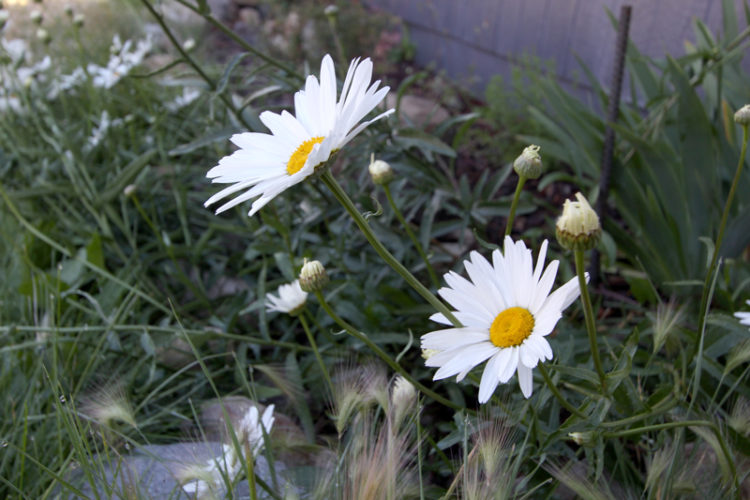
There are numerous cultivars available. The one in my back yard has more substantial leaves than ox-eye daisies, some with a serrated edge so neat they look like they have been trimmed with fine pinking shears. The stem leaves get long and lance-shaped, with serrated or toothed edges. Shasta daisy flower heads are bigger than those of ox-eye daisy. The greens are easy to throw into a dish, especially if they grow in your garden. My favorite preparation so far has been to serve them warm and slightly wilted, cut rough with dandelion greens and chopped walnuts, and tossed in a chili-infused, oil-vinegary yucca flower antipasto. Like ox-eye daisy greens, Shasta daisy greens have a strong and unique flavor, so it’s best to taste before you waste. I like them shredded into thin ribbons and incorporated into salads with other greens too.
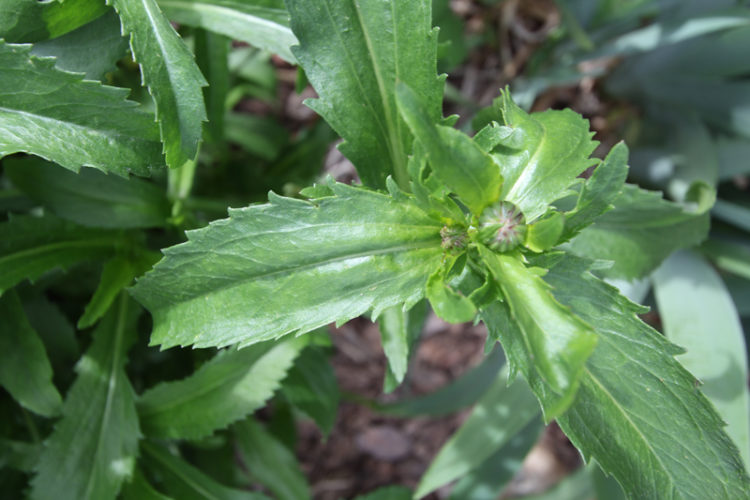
You Say Wild Chamomile, I Say Pineapple Weed
There’s yet another daisy-like plant you might know but not tend to notice unless you’re looking for it. It hangs around the edges of sidewalks and parking lots, and can also be used for food. This low-growing plant is pineapple weed, also known as “false chamomile” or “wild chamomile” (Matricaria discoidea). It looks a lot like the crazy daisy with its frilly foliage, but instead of having full daisy heads, it makes pineapple-shaped clusters of disk flowers only, such that it looks like a tiny conical daisy without the white petals.
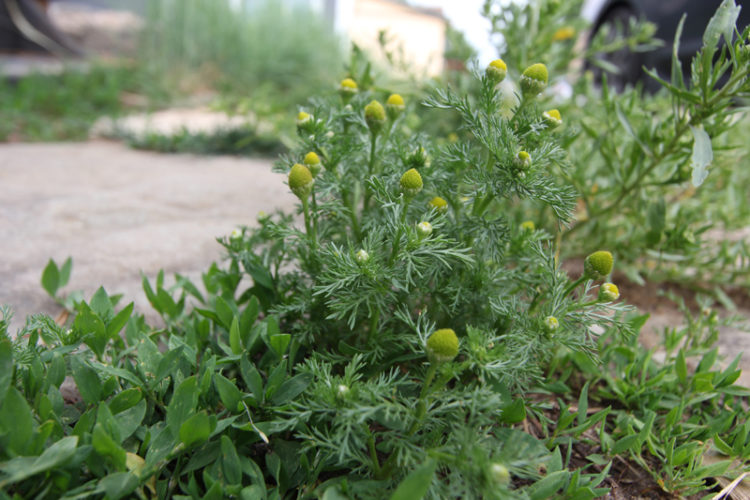
If you crush these flower heads between your fingers you get a pineapple-like aroma. Or, some recognize an olfactory similarity to chamomile, to which wild chamomile is related. This flower head is the part commonly used—whether raw in salads or steeped for tea. The frilly leaves are pretty and edible too. They lend a nice visual character to a dish—but go easy, as they are rather bitter.
I have made salad dressings and infused vodkas with pineapple weed flowers, with good results. Melany Vorass Herrera includes a recipe for pineapple weed sugar cookies in her book, The Front Yard Forager (2014). Pineapple weed is not a noxious weed list species in my state, but it does have weedy tendencies, following humans around wherever we wreak havoc on the environment. It’s best to seek out a clean location if you plan to eat them—a spot not trodden by too many feet, or situated next to a busy road.
A Tale of 10,000 Daisies
I have not done an actual count of how many edible daisies and daisy-like flowers there are. The number 10,000 is an exaggerated estimate, to which I am prone. But there are many more, in the Aster family, that are edible. Get excited, people. The buck so does not stop here.
Updated 2.22.21

I wanted shasta daysies but a pot cost $19.95 at Lowes, so I was sad until I saw these daysies on Route 1 going home! Next day I took a shovel and went hunting for them, now I am so happy, I dig them out with chunks of dirt around and planted around my fence, I know the flowers are smaller but they were free and instantly I have flowers that make me happy!
Well if you ever come through Fairplay, Colorado you are welcome to dig up a pot of my Shasta daisies. Sincerely, erica
Well..based on your article I did sauté the leaves of the Shasta daisy today…and interestingly it turned crispy instead of a mush and tasted delicious and crispy which I had as a snack! Will try the flower tomorrow
Oh neat! Thanks for the report. I’m curious to see how you like the flower.
Oh neat! Glad you liked them.
I have been eating these in class and telling my friends to try them. They don’t, bc they think it’s gross. But my professor told me you could eat them. This article proves that Eli was right!